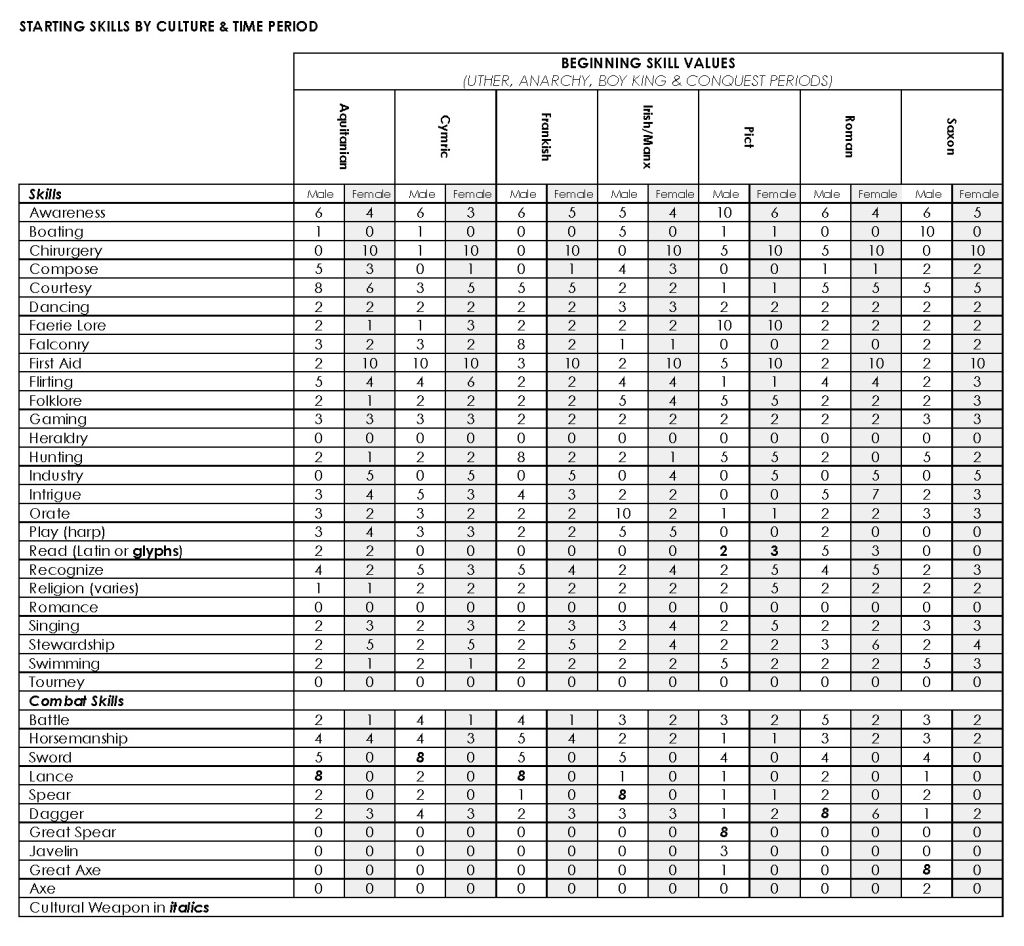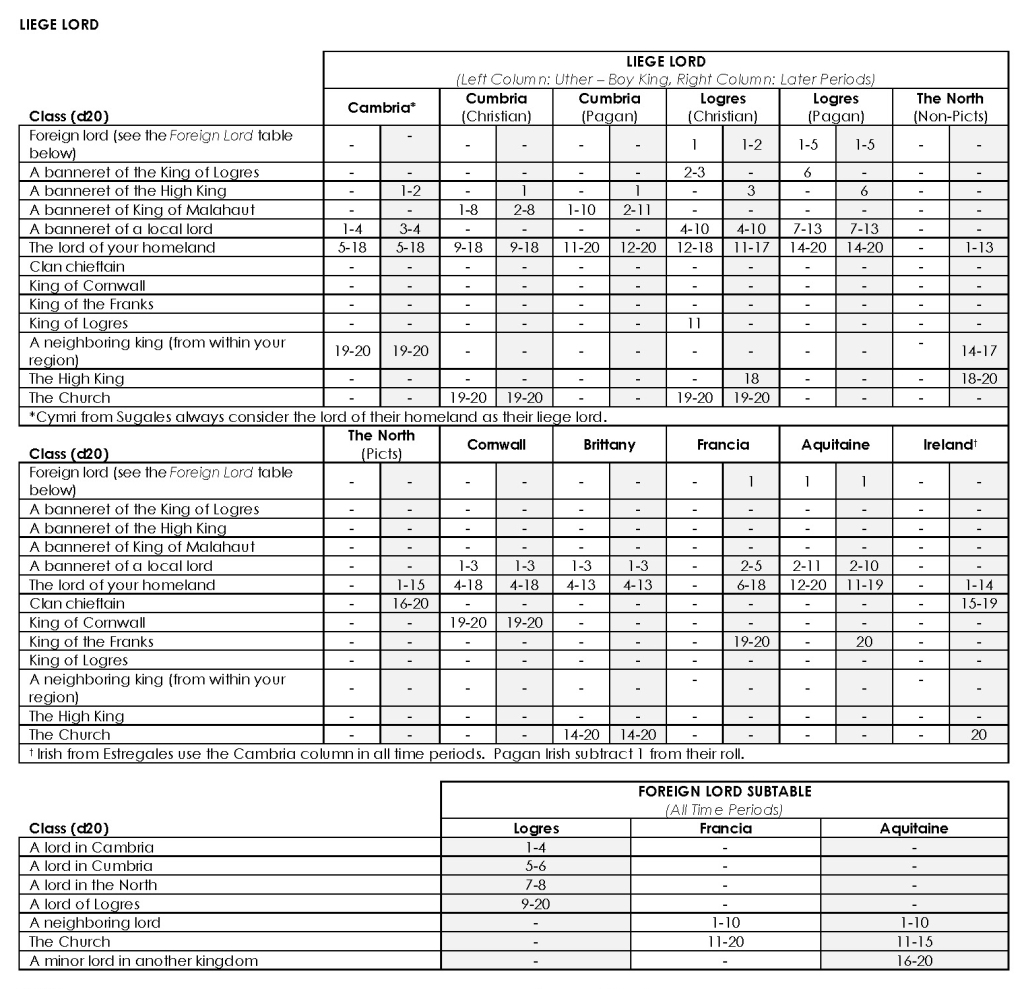
FATHER’S CLASS


INHERITED GLORY, SKILLS, TRAITS, PASSIONS & OUTFIT
Legionarius
Glory: 3d6+50
18 skills points, Awareness +1, Spear +1, Sword +1, Grapple +2, Dagger +3
Proud +1, Prudent +1d3, Selfish +1d3+2, Cruel +1d6, Valorous +1, Honor +1d3, Loyalty (Lord) +1
Legionarius Outfit
Squire
Glory: 6d6
20 skill points, Alertness +2, Heraldry +2 (substitute Recognize in the Uther – Anarchy periods), Horsemanship +2
Energetic +1d3, Modest +1d3, Prudent +1d3, Valorous +1d6, Loyalty (Lord) +3
Outfit 1 (Footsoldier’s Outfit for Irish and Pictish characters)
Mercenary Knight
Glory: 6d6+100
20 skill points, Sword +3, any other weapon +3
Cruel +1d6, Valorous +1d3
Outfit 2 (Outfit 3 for Roman characters)
Warrior
Glory: 6d6+50
24 skill points, Awareness +2, Spear +2, Cultural Weapon +3
Proud +1, Reckless +1d3, Valorous +1d3+2, Honor +1d6, Loyalty (Lord) +3
Cultural Warrior Outfit
Family Chieftain
Glory: 2d6+100
28 skill points, Cultural Weapon +2
Love (family) +1d3, Valorous +1d3, Honor +1d3, Loyalty (Lord) +1d3+3
Cultural Warrior Outfit
Tribal or Clan Chieftain
Glory: 6d6+250
30 skill points, Cultural Weapon +3
Valorous +1d3, Loyalty (Clan) 2d6+6, Honor +1d6
Cultural Warrior Outfit
Bachelor Knight
Glory: 6d6+250
26 skill points
Valorous +1, Loyalty (Lord) +3, Honor +1
Outfit 3 (Outfit 2 for Frankish, Irish, Pictish & Saxon characters)
Vassal Knight
Glory: 6d6+250
30 skill points
Valorous +2, Loyalty (Lord) +4, Honor +1
Outfit 3 (Outfit 2 for Frankish, Irish, Pictish & Saxon characters)
Banneret Knight
Glory: 6d6+250
32 skill points
Valorous +3, Loyalty (Lord) +5, Honor +1d3
Two rolls on the Luck table
Outfit 3 (Outfit 2 for Frankish, Pictish & Saxon characters)
Officer
Glory: 6d6+300
26 skill points plus see below
Valorous +1, Loyalty (Lord) +4, Honor +1d3
- Seneschal: Stewardship +4, Intrigue +2, Hospitality +1d3
- Marshal: Battle +3, Valorous +1d3
- Butler: Courtesy +3, Intrigue +1, Generous +3
- Chamberlain: Read (Latin) +4, Heraldry +2 (substitute Recognize in the Uther – Anarchy periods)
- Constable: Tourney +3 (substitute Battle in the Uther – Anarchy periods), Horsemanship +2
- Forester: Awareness +2, Falconry +2, Hunting +4
- Castellan: Battle +2, Courtesy +2, Stewardship +2
Outfit 4 (Outfit 3 for Frankish & Saxon characters)
Lord
Glory: 6d6+300
26 skill points, Courtesy +2, Heraldry +2 (substitute Recognize in the Uther – Anarchy periods), Intrigue +2, Battle +2, Sword +2, Spear +2
Proud +1d3, Loyalty (Lord) +6, Honor +3, Valorous +1d3
Three rolls on the Luck table
Outfit 4 (Outfit 3 for Saxon characters)
Free Holding Knight
Glory: 6d6+250
26 skill points, Stewardship +2, Courtesy +2, Intrigue +2, Battle +2, Sword +2
Proud +1d3, Loyalty (Lord) +1d3, Honor +1d3, Valorous +1d3
Two rolls on the Luck table
Outfit 4
INHERITED OUTFITS
UTHER-BOY KING PERIOD
Legionarius Outfit
Leather and open helm (4 pt), spear, legionary shield (9 pt), sword, dagger, clothing worth 60d.
Cymric Warrior’s Outfit
Leather armor (4 pt), spear, shield, sword, clothing worth 90d.
Pictish Warrior’s Outfit
No armor, 2 great spears, 5 javelins, great axe, dagger, clothing worth 10d.
Irish Warrior’s Outfit
Leather armor (4 points), 2 spears, shield, sword, dagger, clothing worth 60d.
Saxon Warrior’s Outfit
Cuirbouilli (6 pt), 2 spears, shield, sword, great axe, 3 javelins, dagger, clothing worth 60d.
Outfit 1
Rouncy, leather armor (4 pt), spear, shield, sword, dagger, clothing worth 90d.
Outfit 2
Charger, cuirbouilli (6 pt), spear, shield, sword, dagger, clothing worth 120d.
Oufit 3
Charger, rouncy, Norman chainmail (10 pt), 2 spears, shield, sword, dagger, clothing worth 1L.
Oufit 4
Charger, palfrey, 2 rouncies, Norma chainmail (10 pt), 2 spears, shield, sword, any one other available weapon, dagger, clothing worth 2L, 120d in money.
Outfit 5
2 chargers, palfrey, 2 rouncies, Norman chainmail (10 pt), 2 spears, shield, sword, any one other available weapon, dagger, clothing worth 4L, 1L in money.
Oufit 6
2 chargers, palfrey, 2 rouncies, Norman chainmail (10 pt), 2 spears, shield, sword, any one other available weapon, dagger, clothing worth 2L, 120d in money.
CONQUEST-TWILIGHT PERIOD
Foorsoldier’s Outfit
Leather armor (4 pt), great spear, sword or other cultural weapon, dagger, clothing worth 80d.
Cymric Warrior’s Outfit
Leather armor (4 pt), spear, shield, sword, dagger, clothing worth 120d.
Pictish Warrior’s Outfit
No armor, 2 great spears, 5 javelins, great axe, dagger, clothing worth 10d.
Irish Warrior’s Outfit
Leather armor (4 points), 2 spears, shield, sword, dagger, clothing worth 60d.
Saxon Warrior’s Outfit
Cuirbouilli (6 pt), 2 spears, shield, sword, great axe, 3 javelins, dagger, clothing worth 60d.
Outfit 1
2 rouncies, cuirbouilli (6 pt), spear, shield, sword, dagger, clothing worth 120d.
Outfit 2
Charger, 2 rouncies, Norman chainmail (10 pt), 2 spears, shield, sword, 5 jousting lances, dagger, clothing worth 1L.
Oufit 3
Charger, palfrey, rouncy, reinforced chainmail armor (12 pt), 2 spears, shield, sword, any one other weapon, 5 jousting lances, dagger, clothing worth 2L., 1L in money, 1 squire.
Oufit 4
1 Andalusian charger, palfrey, courser, 2 rouncies, reinforced chainmail armor (12 pt), 2 spears, shield, sword, any one other weapon, 5 jousting lances, dagger, clothing worth 4L., 2L in money, 2 squires.
Outfit 5
1 destrier, 1 Barb charger, 1 Camargue palfrey, 1 rouncy, 1 sumpter, partial plate armor (14 pt), leather hunting armor (2 pts), 6 spears, 2 shields, 2 swords, any two other weapons, 10 jousting lances, dagger, clothing worth 8L., 2L in money, 3 squires.
Oufit 6
1 Frisian destrier, 1 Andalusian chargers, 1 Camargue palfrey, 2 rouncies, 1 sumpter, partial plate armor (14 pt), engraved hunting leather armor (2 pt), 6 spears, 2 shields, 2 swords, any four other weapons, 10 jousting lances, dagger, clothing worth 10L., 3L in money, 4 squires.
LUCK BENEFITS
| d20 roll |
CYMRIC |
d20 roll |
AQUITANIAN |
d20 roll |
FRANKISH |
| 01 |
3d20 denarii. |
01 |
3d20 +60 denarii. |
01 |
3d20 +60 denarii. |
| 02-03 |
3d20+120 denarii. |
02 |
1 Librum (240 denarii). |
02-03 |
1 Librum (240 denarii). |
| 04-06 |
1 Librum (240 denarii). |
03-04 |
1d3 Librum. |
04 |
1d3 Librum. |
| 07 |
1d3 Librum. |
05 |
1d6 Librum. |
05 |
1d6 Librum. |
| 08 |
1d6 Librum. |
06-07 |
Your forebear died heroically: +100 Glory. |
06 |
Your forebear died heroically: +100 Glory. |
| 09 |
Family heirloom: Christian* sacred relic, roll a d6 (1=finger, 2=tears, 3-4=hair, 5=bone fragment, 6=blood) |
08-10 |
Your ancestor was a Visigoth king (1d6+2 generations back): +100 Glory and a jeweled sword worth 1d3 Librum. |
07-10 |
Family heirloom: a brooch. Roll 1d6 for value (1-3 = silver worth 1 L., 4-5 = gold worth 3 L., 6 = silver with diamond worth 5 L.). |
| 10 |
Family heirloom: Ancient bronze sword (+1 to Sword skill when used). Breaks as a non-sword in combat due to its weak blade. Worth 2L. |
11-12 |
A sumpter |
11-13 |
A magical healing potion that heals 1d6 damage once. Priceless. |
| 11 |
Family heirloom: Blessed spear (+1 modifier to Spear skill when used, until broken). Worth 120 denarii. Note: Replace with a lance after the Anarchy period |
13-15 |
A rouncy |
14-15 |
A sumpter |
| 12 |
Family heirloom: Decorated saddle. Worth 1 Librum. |
16 |
A charger |
16 |
A rouncy |
| 13 |
Family heirloom: Engraved finger ring. Roll 1d6 for value (1-4 = silver ring worth 120 denarii, 5-6 = gold ring worth 2 L.). |
17 |
A Barb courser |
17 |
A charger |
| 14 |
Family heirloom: Armband. Roll 1d6 for value (1-5 = silver band worth 1 L., 5-6 = gold band worth 8 L.). |
18 |
An Andalusian charger |
18 |
An Andalusian charger |
| 15 |
Family heirloom: Valuable cloak worth 1 Librum. Roll 1d6 for origin (1-2 = Byzantine, 3=German, 4-5=Spanish, 6=Roman). |
19 |
Upgrade your Outfit by 1 |
19 |
Upgrade your Outfit by 1 |
| 16 |
A magical healing potion that heals 1d6 damage once. Priceless. |
20 |
Roll twice more, re-rolling further rolls of “20”. |
20 |
Roll twice more, re-rolling further rolls of “20”. |
| 17-18 |
A charger |
|
|
|
|
| 19 |
Upgrade your Outfit by 1 |
|
|
|
|
| 20 |
Roll twice more, re-rolling further rolls of “20”. |
|
|
|
|
| * Pagan Cymri gain 1d6 L. in place of this relic. |
|
|
|
|
| d20 roll |
IRISH & MANX |
d20 roll |
PICT |
d20 roll |
ROMANS |
| 01 |
3d20 +60 denarii. |
01-03 |
3d20 denarii. |
01 |
3d20 +60 denarii. |
| 02 |
1 Librum (240 denarii). |
04 |
Your forebear died heroically: +100 Glory. |
02-03 |
1 Librum (240 denarii). |
| 03-04 |
Your forebear died heroically: +100 Glory. |
05 |
A rouncy |
04 |
1d3 Librum. |
| 05 |
A Connacht rouncy. |
06-10 |
You bear a magical tattoo that provides 2 points of armor |
05-06 |
1d6 Librum. |
| 06-10 |
A charger |
11 |
You have a magical charger, +1 movement rate and +1d3 armor |
07-10 |
Your ancestors came to Britain from Rome(1d6+2 generations back): +100 Glory. |
| 11 |
An Irish courser |
12 |
1d3 magical healing potions that heal 1d6 damage. Priceless. |
11-12 |
A charger |
| 12-16 |
Your are a descendant of a king (1d6+2 generations back): +150 Glory |
13 |
The faeries have gifted you with a magical great spear of impressive power, +2 to Spear skill until broken. +100 Glory. Priceless. |
13 |
An Andalusian charger |
| 17 |
1d3 magical healing potions that heal 1d6 damage. Priceless. |
14-15 |
1d6 magical healing potions that heal 1d6 damage. Priceless. |
14 |
A Barb courser |
| 18 |
A love potion. Priceless. |
16 |
1d3 love potions. Priceless. |
15-16 |
A magical healing potion that heals 1d6 damage once. Priceless. |
| 19 |
Upgrade your Outfit by 1 |
17-19 |
1d3 strong healing potions (each heals 6 damage). Priceless. |
17-18 |
A strong healing potion that heals 6 points of damage once. Priceless. |
| 20 |
Roll twice more, re-rolling further rolls of “20”. |
20 |
Roll twice more, re-rolling further rolls of “20”. |
19 |
Upgrade your Outfit by 1 |
|
|
|
|
20 |
Roll twice more, re-rolling further rolls of “20”. |
| d20 roll |
SAXON |
d20 roll |
SAXON (continued) |
| 01-03 |
3d20 denarii. |
14 |
You have a part-share in a ship. Check with the gamemaster for details. |
| 04 |
1d3 Librum. |
15 |
You have a blessed axe. +1 to Great Axe skill when used. Breaks normally. Worth 2 Librum. |
| 05-07 |
Wotan is your ancestor: +200 Glory |
16-18 |
A magical healing potion that heals 1d6 damage once. Priceless. |
| 08-10 |
A sumpter |
19 |
Upgrade your Outfit by 1 |
| 11 |
A rouncy |
20 |
Roll twice more, re-rolling further rolls of “20”. |
| 12-13 |
A charger |
|
|















